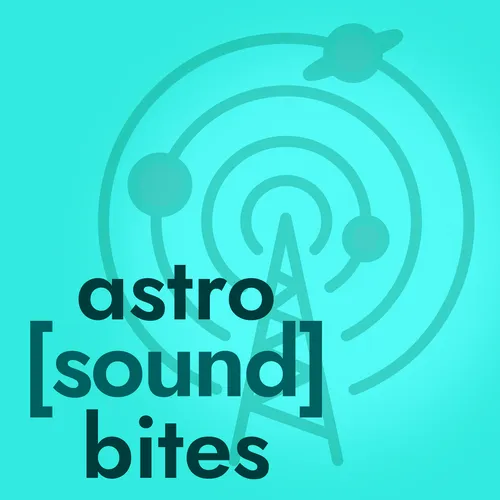![astro[sound]bites - Podcast](https://b2.eachpod.com/podcast-imgs/469bea6f5b8050598de4830685fd6027.webp)
astro[sound]bites
Astrobites for your ears. Three grad students bring you cutting-edge research findings in astronomy and connect the dots between diverse subfields.
- Update frequency
- every 13 days
- Average duration
- 46 minutes
- Episodes
- 121
- Years Active
- 2019 - 2025

Episode 40: Space Summer Surprise
We’re back from vacation! We play 2 truths and a lie about what we did this summer and learn that the truth might be subjective. Alex brings a BBQ-themed Astrobite about the brightest galaxies, teach…

Episode 39: Polarizing Protostars
Billions of years before Van Gogh put paint to canvas and immortalized them forever, the stars in the sky were nothing more than an intricate tangle of magnetic fields and swirling gas. Turn the cloc…

Episode 38: Keep Your Head in the Clouds
Tired of vacations being ruined by cloudy weather? Alex the travel agent can book your next trip to brown dwarf binary 1416B, where it’s always a balmy 2000 degrees and never cloudy. Or maybe a sojou…

Episode 37: How to Date a Star
In this episode, we discuss the varied methods used to determine stellar ages. Alex shares how planetary companions can slow the spin of twirling stars, Will compares the spectroscopic fingerprints …

Episode 36: A Dance with Dark Matter
How can astronomers study something that nobody has ever seen? In this episode, we switch to the dark side to shine a light on one of the biggest questions in all of astrophysics: the nature of dark …

Episode 35: The Road Less Traveled
In this Beyond episode, we veer off the traditional path to a PhD with three interviews from early-career astronomers who did things a little bit differently.
Tim Holt shares his transitions from zo…

Episode 34: Where Classifications Crumble
You’ve heard about planets, stars, galaxies, and other “types” of astronomical objects on the show -- but what about the objects that defy our classification schemes? Will discusses how a mysterious …
![Episode 33: Beyond A[S]B -- Scintillating Sounds of Science](https://b2.eachpod.com/podcast-imgs/469bea6f5b8050598de4830685fd6027.webp)
Episode 33: Beyond A[S]B -- Scintillating Sounds of Science
Do we have to explore astronomy data with our eyes? What if we used our ears? In this episode, we explore these and other questions in the growing field of sonification. Find out what an interstella…

Episode 32: Highlights of Undergraduate Research
In this episode we zip through a flurry of exciting undergraduate research Astrobites. Malena weaves a tale of solar tornadoes and cometary corkscrews, Alex spins a yarn of spiders and snowy telescop…

Episode 31: Hypervelocity Heavens
Episode 31: Hypervelocity Heavens
Today we pump the gas to get up to speed on the hypervelocity objects of our universe. Alex divulges how hypervelocity stars tell us about their black hole origin…

Episode 30: Carnivorous Cosmos
It’s a harsh world out there, as the gang learns by trekking out to observe accretion in the wild. Will peers through his simulation binoculars to see whether tidal disruption events can really satis…

Episode 29: Walking on Sunshine
In this episode, we’re blown back and blown away by the solar wind. Will offers a historical overview of how Eugene Parker discovered the solar wind without running a single experiment. Malena covers…

Episode 28: Blink and You'll Miss It
We were going to write show notes, but it’s been a little while since we recorded and we forgot what we talked about. I guess you could call our memory…. transient!
In this episode we discuss some of…

Episode 27: Where the Sidewalk Bends
We’re starting off the new year right by getting ahead of the curve! In this topsy-turvy episode, we tackle the stretching and curving of non-Euclidean geometry -- where it came from, why it teaches …

Episode 26: Surfing on a Dream
Ever experience the last rays of sunlight sparkling across the ocean? In this episode, PhD student Michael Heslar tells us how we can use this twinkling across the methane seas of Titan to study wave…
![Episode 25: Beyond A[S]B -- Great Advisors, Gap Years, and Getting into Grad School](https://b2.eachpod.com/podcast-imgs/469bea6f5b8050598de4830685fd6027.webp)
Episode 25: Beyond A[S]B -- Great Advisors, Gap Years, and Getting into Grad School
Please describe a time in your life when you experienced and overcame hardship.
Well, middle school wasn’t great...I stubbed my toe this morning….how much detail are you looking for here??
The decisi…

Episode 24: The Stargazing Automata, Part IV
Planets and quenching and stars, oh my! In this finale to our four-part series on machine learning in astrophysics, the team hits the (virtual) road to hear from the experts. Our first stop is Irvine…

Episode 23: The Stargazing Automata, Part III
They say the 20th century explorers were astronauts. The 21st century explorers might be data scientists using unsupervised learning methods to explore big data. In this episode, we learn Alex and co…

Episode 22: The Stargazing Automata, Part II
Today we get to talk about everyone’s favorite problem: too much data and too little time! It’s not yet Halloween, but today’s spooky episode is full of GHOSTs and ASSASNs. Alex shares his recent wor…

Episode 21: The Stargazing Automata, Part I
This episode takes us into dark notions and oscillating questions! Malena spices rocks that orbit remote places and Will covers his dwarfs with tenderness and instability.
Okay, so none of this is …